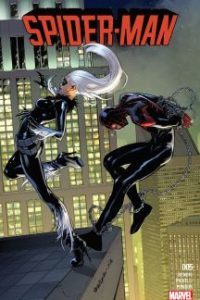Daniel Sherrier's Blog, page 19
January 5, 2017
Today’s Super Comic — Spider-Man #5 (2016)
In #5, Spider-Man (Miles Morales) is captured by Black Cat, foe and ex-girlfriend of the original Spidey, and Hammerhead, foe of the original Spidey but not an ex. His best friend has to cover for him with his mother, shortly after he’s committed a major secret-identity faux pas. His father meets with a certain government agency to protect him. His grandmother hires a certain private investigator to see if Miles is doing drugs. And a former trainee of a certain mutant team has entered his life.
The book is so full of character. Life is never easy for the protagonist. No one in the supporting cast lacks motivation for their behavior. And the various plotlines move forward at just the right pace, always plenty going on.
It’s Spider-Man as he’s meant to be, even if he’s not Peter Parker in this case.
Writer: Brian Michael Bendis
Artist: Sara Pichelli
Publisher: Marvel Comics
How to Read It: recent back issues; Marvel Unlimited; Comixology; included in Spider-Man: Miles Morales vol. 1
Appropriate For: ages 10 and up
January 4, 2017
Today’s Super Comic — Mockingbird #4 (2016)
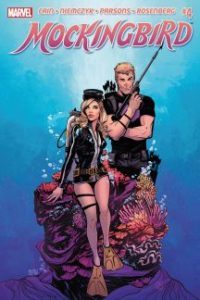 I see what they did there. Hawkeye is cast as the scantily-clad damsel in distress, and the fully clothed Mockingbird comes to his rescue.
I see what they did there. Hawkeye is cast as the scantily-clad damsel in distress, and the fully clothed Mockingbird comes to his rescue.
This kind of thing should happen more often—well, not the scantily clad part, as no one in a comic ever needs to be scantily clad. But women should be saving men as much as men save women.
While that’s the more obvious feminist hook of Mockingbird #4, there’s another that I would think is even more important—the fact that Bobbi Morse is getting greater character development than she’s ever received. In the books I’ve read, she’s primarily served the role of Hawkeye’s wife or ex-wife. For the first time, she comes alive as her own character.
And in addition to all that, this is a solid, engaging comic with a great sense of humor.
Writer: Chelsea Cain
Penciler: Kate Niemczyk
Inker: Sean Parsons
Publisher: Marvel Comics
How to Read It: recent back issues; Marvel Unlimited; Comixology; included in Mockingbird vol. 1: I Can Explain (TPB)
Appropriate For: ages 13 and up
January 3, 2017
Today’s Super Comic — Captain America #25 (2007)
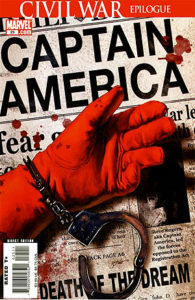 If you simply must kill the title character, this is the way to go about it.
If you simply must kill the title character, this is the way to go about it.
Captain America #25 made national news when it came out. Must’ve been a slow news day if fictional events were considered newsworthy, especially given death’s well-known lack of permanency in the comic book realm.
We know Captain America isn’t going to stay dead forever, and no one tries to fool us about it. His death isn’t treated as the climactic event of the character’s story; it’s the inciting incident of this new story, which will carry the title for a while after. It’s not so much about how Cap dies, but more about setting up uncertainty about what will happen while Cap is dead.
Interestingly, writer Ed Brubaker and artist Steve Epting initially seem to present the death as a murder mystery. Cap takes a bullet for a stranger—a very Captain America thing to do—and in the commotion that follows, we see a gun drawing closer to him and shooting him point-blank in the gut. But we don’t see who fired the lethal shot. It’s a crowded, chaotic scene. Any number of people could’ve slipped in and done it. It looks like that question may be left unanswered for the time being.
Nope. We learn the identity of the shooter in the final pages, and rather than deflating the tension, this knowledge enhances the drama, demanding we read the next issue.
By the way, this issue also serves as an epilogue to the original “Civil War” crossover storyline, but that’s not essential reading for this story. You’ll get up to speed quickly enough.
Writer: Ed Brubaker
Artist: Steve Epting
Publisher: Marvel Comics
How to Read It: back issues; Marvel Unlimited; Comixology; included in Captain America: The Death of Captain America vol. 1 (TPB)
Appropriate For: ages 14 and up
January 2, 2017
Today’s Super Comics — The Ultimates #1-13 (2002-03)
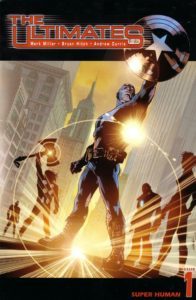 The original Ultimates series basically asked, “What would the Avengers be like in the real world?”
The original Ultimates series basically asked, “What would the Avengers be like in the real world?”
They’d be really messed up people, apparently, and hardly straightforward heroes.
Written by Mark Millar, it’s a more cynical take on the team than I’d normally like, but as a change of pace, it’s excellent and full of interesting ideas. The reinterpretation of Thor is particularly amusing—it’s ambiguous whether he’s actually the son of Odin or just a delusional hippie who happens to have powers. Also, when the team battles the Hulk in New York City, collateral damage is shown to be a real concern; super-action has consequences. And at one point, Nick Fury suggests Samuel L. Jackson should play him in a movie, several years before Jackson cameoed in the first Iron Man.
Artist Bryan Hitch creates exactly the right visual tone for this down-to-earth series. The art is detailed, and people look like people rather than cartoons.
The series is easily the second-best usage of Marvel’s Ultimate Comics imprint (after Ultimate Spider-Man, of course). Let’s just be thankful these aren’t the Avengers of the proper Marvel Universe or even the Marvel Cinematic Universe.
Writer: Mark Millar
Penciler: Bryan Hitch
Inker: Paul Neary
Publisher: Marvel Comics
How to Read It: back issues; Marvel Unlimited; Comixology; The Ultimates: Ultimate Collection (TPB)
Appropriate For: ages 15 and up
January 1, 2017
Today’s Super Comics — Flashpoint #1-5 (2011)
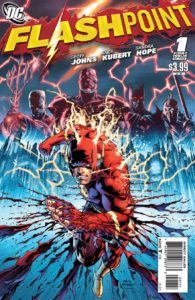 The Flash broke the DC Universe. He messed with the timeline, resulting in the New 52, which I am not a fan of, barring a handful of notable exceptions. It’s unfortunate. But the storyline in which he ruined everything was pretty great.
The Flash broke the DC Universe. He messed with the timeline, resulting in the New 52, which I am not a fan of, barring a handful of notable exceptions. It’s unfortunate. But the storyline in which he ruined everything was pretty great.
Flash (Barry Allen) interferes with time for a noble, human reason—he wants to save his mother, who was murdered many years ago by a time-traveling Reverse Flash (kind of like in the TV series). So Barry has a strong justification for his actions, but he nevertheless creates an alternate timeline in need of serious repair. The most compelling reason: A feud between these non-heroic versions of Wonder Woman and Aquaman is putting the whole world on the brink of war.
Flashpoint’s standout alternate version of a character is Batman, who isn’t Bruce Wayne here—he’s Bruce’s father, Thomas Wayne. In this world, Bruce and his mother Martha were murdered by a mugger, and Thomas was the sole survivor. So when Barry comes along speaking of a better world in which Bruce survives, Thomas has powerful motivation to help him out, crazy as he sounds. What parent wouldn’t want to trade places with their child in that situation?
Yesterday, I mentioned how Zero Hour lacked a central protagonist. DC seemed to have learned its lesson seventeen years later. Flash anchors the series and guides us through. He’s the only one from “our” world and therefore the only one who can ultimately set things right (not that he nails the target perfectly, but that’s irrelevant to judging this series on its own merits).
As someone who grew up with the Wally West Flash, this is one of the better Barry Allen stories I’ve read.
Writer: Geoff Johns
Penciler: Andy Kubert
Inker: Sandra Hope
Publisher: DC Comics
How to Read It: back issues; Comixology; Flashpoint (TPB)
Appropriate For: ages 12 and up
December 31, 2016
Today’s Super Comics — Zero Hour #4-0 (1994)
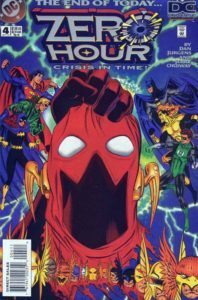 Zero Hour was the first company-wide crossover event I read, and the scope was suitably epic.
Zero Hour was the first company-wide crossover event I read, and the scope was suitably epic.
The superheroes of the DC Universe need to band together to save time itself, which is rapidly unraveling, creating all sorts of mysterious (and entertaining) anomalies. A young Batgirl in her prime appears in Gotham. People randomly disappear as their timelines are wiped out. The elder statesmen of the Justice Society of America stage a heroic last stand.
And at the center of it all is a classic DC superhero gone rogue. (Spoilers ahead, since I can’t really discuss this one without revealing the big bad.)
The most amazing part for me, when I read this at the age of 11, was the reveal of the villain. In the final pages of the penultimate issue, a green glowing fist clocks Superman, knocking him out cold, and then we see Hal Jordan, the definitive Green Lantern since the 1959, standing over him, taking credit for orchestrating this whole crisis in time.
It blew my young mind—the idea of a hero of this stature being the bad guy. And Green Lantern, now calling himself Parallax, is utterly convinced he’s in the right, which is an important ingredient in any great villain. He’s fixing time and removing all the mistakes. Basically, he’s playing God to bring about a utopian vision. And that never goes well.
It’s no work of literature, but it thrilled me back in the day. It lacks a central protagonist, but lots of great characters have their moments, especially Green Arrow in the final faceoff against his old friend. The Flash also gets a big heroic moment early in the series.
By the way, the numbering for this miniseries goes backward. So the first issue is #4, second is #3, and so on. It’s a countdown to the end of time. Happy New Year’s Eve.
Writer/Penciler: Dan Jurgens
Inker: Jerry Ordway
Publisher: DC Comics
How to Read It: back issues; Comixology; Zero Hour: Crisis in Time (TPB)
Appropriate For: ages 9 and up
December 30, 2016
Today’s Super Comic — Batman #17 (2013)
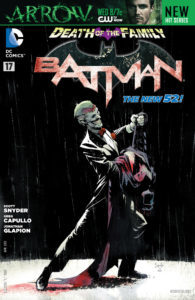 Batman’s “Death of the Family” story arc is one of the most disturbing Joker stories I’ve read. It’s also one of the richest psychologically.
Batman’s “Death of the Family” story arc is one of the most disturbing Joker stories I’ve read. It’s also one of the richest psychologically.
Writer Scott Snyder drills into the heads of Batman and the Joker, amazingly giving a fresh spin to an antagonistic relationship that’s been going on for over seventy years. On the surface, it’s creepy as hell and far too nightmarish for children to read, but lots of careful thought clearly went into the narrative. The payoff in issue #17 is brilliant. Once you get past the grotesqueries, you find an intelligent comic hiding within.
It really shows just how versatile these characters are. They fit a seemingly endless variety of stories.
But keep the kiddies away from this one!
Writer: Scott Snyder
Penciler: Greg Capullo
Inker: Jonathan Glapion
Publisher: DC Comics
How to Read It: back issues; Comixology; included in Batman vol. 3: Death of the Family (TPB)
Appropriate For: ages 15 and up
December 29, 2016
Today’s Super Comic — Starman #37 (1997)
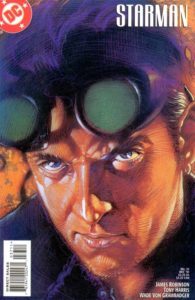 Starman had an annual tradition. Once a year, Jack Knight would spend an issue chatting with his deceased brother, David, in a dreamlike realm that may or may not have been an actual dream. Each occurrence was titled “Talking with David, [year].”
Starman had an annual tradition. Once a year, Jack Knight would spend an issue chatting with his deceased brother, David, in a dreamlike realm that may or may not have been an actual dream. Each occurrence was titled “Talking with David, [year].”
Pretty much the entire issue would be rendered in black and white except for David in the classic Starman costume, which received full-color treatment. These talks were a clever way to chart Jack’s growth as a superhero and a man by taking a dialogue-oriented break from the action.
The best iteration I’ve read so far is in issue #37, in which the brothers share a meal with the deceased members of the Justice Society of America, including Hourman, Dr. Mid-Nite, the original Black Canary, and others. These first-generation superheroes take turns sharing their wisdom with Jack, while D-list Golden Age hero Red Bee provides some tension with his inexplicably rude behavior…which winds up tying into his own bit of wisdom.
As a special treat, the final page eschews the black-and-white motif with a full-color painted splash page, capping the issue with a suitably vintage look.
Writer: James Robinson
Artist: Tony Harris
Inker: Wade Von Grawbadger
Cover: Tony Harris
Publisher: DC Comics
How to Read It: back issues; Comixology; included in Starman Omnibus vol. 3 (HC)
Appropriate For: ages 14 and up
December 28, 2016
Today’s Super Comic — The Vision #12 (2016)
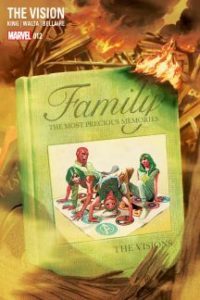 Among what I’ve read, The Vision is the best comic book series of 2016, and it absolutely sticks the landing in its final issue, #12.
Among what I’ve read, The Vision is the best comic book series of 2016, and it absolutely sticks the landing in its final issue, #12.
Similar to what he did with Omega Men, writer Tom King creates a complete story over the course of 12 issues. You can read from #1 through #12 and feel totally satisfied (though he does leave room for sequels). Then you can reread and admire the details and careful thought that went into the plotting and characters, who all come alive with greater depth than the typical comic affords. The main difference between the two series, however, is that Vision makes ample use of previous continuity to enrich the story…and it manages to do so without ever becoming inaccessible.
The series marks a true evolution for its protagonist, both in terms of the character himself (itself?) and the dramatic possibilities of his artificial existence.
At its core, it’s a series about the Vision wanting more in life. While things certainly don’t go as planned, the Avengers’ artificial member has never looked more like a three-dimensional human being…albeit an incredibly odd one.
Read it all from #1.
Writer: Tom King
Artist: Gabriel Hernandez Walta
Cover: Michael Del Mundo
Publisher: Marvel Comics
How to Read It: recent back issues; Comixology; included in The Vision vol. 2: Little Better Than a Beast (TPB)
Appropriate For: ages 14 and up
December 27, 2016
Today’s Super Comic — All-New X-Men #40 (2015)
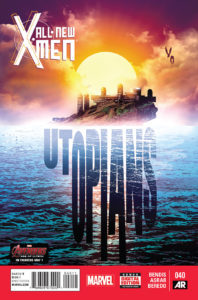 Late in the original run of All-New X-Men, we get a quiet, talky issue, which provides a good opportunity to check in with how extended time-displacement is affecting some of the teenaged original X-Men trapped in the present. The experience is changing some of them, and others are trying to change as a result of what they’ve learned about their futures.
Late in the original run of All-New X-Men, we get a quiet, talky issue, which provides a good opportunity to check in with how extended time-displacement is affecting some of the teenaged original X-Men trapped in the present. The experience is changing some of them, and others are trying to change as a result of what they’ve learned about their futures.
A good chunk of issue #40 focuses on Iceman during a revelatory heart-to-heart with Jean Grey, and also on Angel as he shares a moment with X-23, the young female Wolverine clone. The issue comes after a big cosmic storyline, so pacing-wise, it’s an excellent way to bring us back down to Earth.
Writer Brian Michael Bendis also works in several comedic beats that keep everything fun, while artist Mahmud Asrar deftly handles the shifting facial expressions—which is essential in making a talking-heads issue work in a visual medium.
Remarkably, this time-travel premise was not running out of gas 40 issues in.
Writer: Brian Michael Bendis
Artist: Mahmud Asrar
Cover: Andrea Sorrentino and Marcelo Maiolo
Publisher: Marvel Comics
How to Read It: back issues; Marvel Unlimited; Comixology; included in All-New X-Men vol. 7: The Utopians (TPB)
Appropriate For: ages 12 and up

